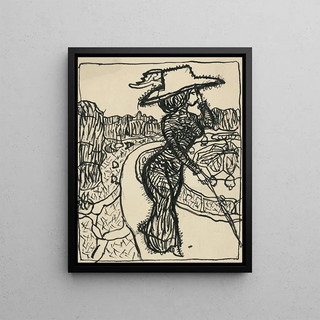Art print | Karikatra dmy - Konstantin Korovin


View from behind

Frame (optional)
Konstantin Korovin’s "Karikatra dmy" art print embodies a captivating fusion between reality and imagination, a visual journey that transports the viewer into a universe where light and color intertwine with rare delicacy. This piece, emblematic of the artist’s style, not only highlights his creative genius but also his ability to capture the essence of the moment. Gazing upon this work, one is immediately struck by a vibrant atmosphere, where each brushstroke seems to tell a story, evoke an emotion, or evoke a sensation. The "Karikatra dmy" thus stands as an invitation to explore the subtleties of early 20th-century Russian art, a period rich in innovations and artistic upheavals.
Style and uniqueness of the work
The style of the "Karikatra dmy" is distinguished by its bold use of colors and shapes, demonstrating an undeniable mastery of pictorial technique. Korovin, influenced by the Impressionist movement, manages to create a luminous and dynamic atmosphere, where nuances and shadows blend harmoniously. The composition of the piece is both balanced and daring, highlighting elements that seem to dance under the light. The depicted characters are imbued with a certain lightness, almost ethereal, inviting the viewer to immerse themselves in their world. This blend of realism and dream, of everyday life and fantasy, gives the "Karikatra dmy" a singularity that makes it unforgettable. Every detail, from the choice of colors to the arrangement of elements, contributes to creating an immersive atmosphere where one feels both an observer and a participant.
The artist and his influence
Konstantin Korovin, an emblematic figure of Russian art, left his mark on his era through his innovative approach and artistic sensitivity. Born in 1861, he was one of the first artists to incorporate elements of landscape and daily life into his works, breaking away from the academic conventions of his time. His journey was marked by travels across Europe, where he was influenced by masters such as Monet and Renoir, but also by the rich cultural heritage of the

Matte finish

View from behind

Frame (optional)
Konstantin Korovin’s "Karikatra dmy" art print embodies a captivating fusion between reality and imagination, a visual journey that transports the viewer into a universe where light and color intertwine with rare delicacy. This piece, emblematic of the artist’s style, not only highlights his creative genius but also his ability to capture the essence of the moment. Gazing upon this work, one is immediately struck by a vibrant atmosphere, where each brushstroke seems to tell a story, evoke an emotion, or evoke a sensation. The "Karikatra dmy" thus stands as an invitation to explore the subtleties of early 20th-century Russian art, a period rich in innovations and artistic upheavals.
Style and uniqueness of the work
The style of the "Karikatra dmy" is distinguished by its bold use of colors and shapes, demonstrating an undeniable mastery of pictorial technique. Korovin, influenced by the Impressionist movement, manages to create a luminous and dynamic atmosphere, where nuances and shadows blend harmoniously. The composition of the piece is both balanced and daring, highlighting elements that seem to dance under the light. The depicted characters are imbued with a certain lightness, almost ethereal, inviting the viewer to immerse themselves in their world. This blend of realism and dream, of everyday life and fantasy, gives the "Karikatra dmy" a singularity that makes it unforgettable. Every detail, from the choice of colors to the arrangement of elements, contributes to creating an immersive atmosphere where one feels both an observer and a participant.
The artist and his influence
Konstantin Korovin, an emblematic figure of Russian art, left his mark on his era through his innovative approach and artistic sensitivity. Born in 1861, he was one of the first artists to incorporate elements of landscape and daily life into his works, breaking away from the academic conventions of his time. His journey was marked by travels across Europe, where he was influenced by masters such as Monet and Renoir, but also by the rich cultural heritage of the






